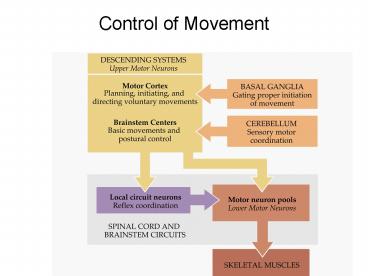Control of Movement - PowerPoint PPT Presentation
1 / 26
Title:
Control of Movement
Description:
... contracting the biceps that would ... Gastrocnemius stimulation happens before biceps. cut reticulospinal tract Biceps will fire but not Gastrocnemius ... – PowerPoint PPT presentation
Number of Views:203
Avg rating:3.0/5.0
Title: Control of Movement
1
Control of Movement
2
Patterns of Connections Made by Local Circuit
Neurons in the Intermediate Zone of the Spinal
Cord Gray Matter
Long distance interneurons project bilaterally,
innervate multiple segments. Used for posture
control.
Short distance interneurons project over a few
segments, remain ipsilateral. Used for distal
muscle groups.
3
Descending Projections from the Brainstem to the
Spinal Cord
4
(No Transcript)
5
Feed forward processing
- Able to predict changes in posture, and generate
an appropriate stabilizing response. - Some muscles fire in anticipation of a need for
postural adjustment. - For example, the gastrocnemius muscle needs to
adjust for the anticipation of contracting the
biceps that would naturally pull the body forward
stabilizing response - Reticular formation and Reticulospinal tract
important for this. - Lesion or pharmacologically block it in a cat and
compensatory muscle changes do not occur. - Stimulate motor cortex in the right place can
induce paw lifting, also induces other limbs
muscles to fire. Inhibit reticulospinal tract,
paw still moves but other legs do not.
6
Anticipatory Maintenance of Body Posture
EMG elecromyography. Measure muscle APs
Gastrocnemius stimulation happens before
biceps cut reticulospinal tract Biceps will fire
but not Gastrocnemius
7
Feedforward and Feedback Mechanisms of Postural
Control
- PN17050.JPG
8
Direct and indirect projections form motor cortex
- Motor cortex makes two types of projections.
- A direct pathway to the ventral lateral spinal
cord - An indirect pathway to the reticular formation
(which subsequently goes to medial spinal cord). - For example a direct pathway will move the hand
and the indirect pathway will posture the body. - Cutting the direct pathway, leaving the indirect
pathways intact will not affect ability to walk,
run, etc, but will prevent the distal parts of
limbs from being used.
9
Pathways from the Motor Cortex to the Spinal Cord
Direct pathway lateral corticospinal
and rubrospinal tracts, distal fine motor
movements. Pyramidal System
10
Pathways from the Motor Cortex to the Spinal Cord
Indirect pathway postural adjustments. Ventral
corticospinal tract, cortico-reticulospinal
tract. Extrapyramidal System
11
Motor cortex
- in the frontal lobe
- several interconnected areas
- Primary motor cortex in the precentral gyrus.
- Gets input from basal ganglia, cerebellum and
other cortical areas. - Has 6 layers, layer V is the output layer
(pyramidal cells or Betz cells). - Primary pathway- the pyramidal system.
12
Architecture of motor cortex is different than
the sensory cortex.
Betz cells
13
The corticospinal tract.
14
(No Transcript)
15
Motor fields
- Stimulation of a neuron in primary motor cortex
activates several muscles, and inhibits other
muscles. - Multiple neurons can activate the same muscle.
- The motor field of a cortical motor neuron has
to do with organized movements rather than
specific muscle groups.
16
Directional Tuning of an Upper Motor Neuron in
the Primary Motor Cortex
Monkey trained to move joystick in response to
light
17
Directional Tuning of an Upper Motor Neuron in
the Primary Motor Cortex
movement starts at 0. Yellow activity of
neuron is increased. Purple activity is
decreased. Neurons have preferred direction
Activity of a single neuron in motor
cortex anticipates future movement.
18
Directional Tuning of an Upper Motor Neuron in
the Primary Motor Cortex
Individual neurons tuned too broadly to
accurately predict movement direction.
Populations of neurons can calculate a direction.
Summed population responses give the actual
direction of movement.
19
Premotor cortex
- Rostral to primary motor cortex
- Extensive reciprocal connections with primary
motor cortex - Also projects directly to spinal cord (30 of
axons in the pyramidal tract).
20
Supplementary premotor cortex
- mediates selection of movements
- specified by internal rather than external cues.
- Cells fire when just thinking about an event.
21
Lateral Premotor Cortex-
- Neurons fire earlier than primary motor cortex.
Important in conditional motor tasks that pair a
movement with a visual cue. - Neurons fire before initiation of the task. Used
for intentions. - Lesions in monkey prevent vision-conditioned
tasks, although vision is ok and the task could
be performed in other ways.
22
Motor cortex areas
23
The Primary Motor Cortex and Premotor Area in the
Human Cerebral Cortex
24
Photograph of sagittal section through brain stem
and cerebellum
25
Cerebellar cortex
26
Cerebellar circuits































